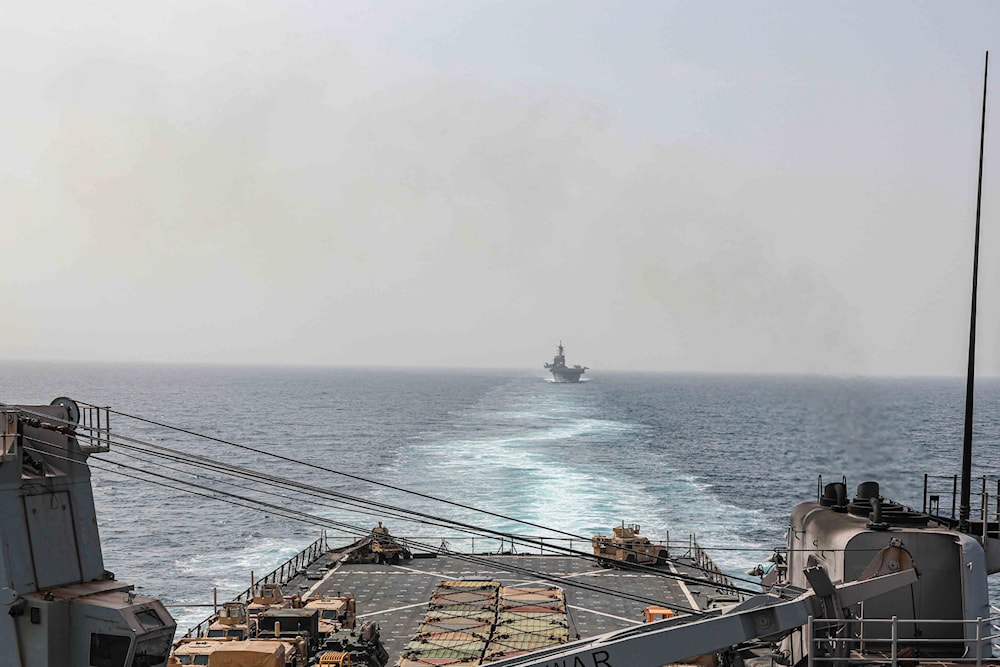US replaces Ford aircraft carrier with assault ship USS Bataan group
The United States is replacing the USS Gerald Ford with an amphibious ready group led by an assault ship after the former was repatriated.
-

Amphibious dock landing ship USS Carter Hall and amphibious assault ship USS Bataan transit the Bab al-Mandeb strait on August 9, 2023 (US Navy via AP)
The United States ordered that an amphibious ready group, led by the assault ship USS Bataan (LHD-5), shift its operations from the Gulf to the Eastern Mediterranean, announced National Security Council spokesperson John Kirby on Wednesday.
The relocation of the Bataan-led amphibious ready group coincides with the departure of the aircraft carrier Gerald R. Ford, which shows that the United States is extensively committed to destabilizing the region.
In August, the USS Bataan and the dock landing ship Carter Hall made their way to the Red Sea from the Mediterranean via the Suez Canal after spending five months in the Gulf. The decision to move the naval assets reflects the dynamic nature of geopolitical tensions in the area.
The Defense Department had previously disclosed reinforcement plans for its Gulf-stationed fleet in July, citing alleged threats posed by Iran to international navigation.
"The amphibious ready group, led by the assault ship USS Bataan, was moved into the Eastern Mediterranean in the recent days coinciding with the departure of the aircraft carrier Gerald R. Ford," Kirby said.
The USS Bataan and Carter Hall will now join the Arleigh Burke-class destroyer Thomas Hudner of the US Fifth Fleet. This fleet operates in an extensive area covering approximately 2.5 million square miles, encompassing parts of the Indian Ocean and the Red Sea.
The United States has decided to bring back the aircraft carrier USS Gerald Ford from the Eastern Mediterranean after it was sent there in light of October 7's Operation al-Aqsa Flood, two US officials told ABC News on Sunday.
USS ford leaving Mediterranean
USS Ford is the US Navy's newest and largest aircraft carrier and right before the end of its first operational deployment, it was sent to the Eastern Mediterranean in a possible bid to stoke tensions in the region that was already in a fragile state due to the Israeli aggression on the Gaza Strip and the broad US support it was receiving in light of the onslaught.
The United States claimed that the deployment was for deterrence purposes, namely against the Lebanese Hezbollah Resistance movement and other regional Resistance and liberation movements and factions.
US Defense Secretary Lloyd Austin claimed at the time the aircraft carrier was sent that its deployment came "As part of our effort to deter hostile actions against Israel or any efforts toward widening this war following Hamas' attack on Israel."
The deployment was extended for a third time in December, with Austin claiming that deterrence was still needed amid heightened regional tensions.
USS Gerald Ford and several other ships that comprise its strike group would be returning to Norfolk, Virginia, the carrier's home port, as originally scheduled so that it could prepare for future redeployments.
"We have nothing to announce today," a Pentagon spokesperson said when asked for a comment by ABC News, after the aforementioned officials said the departure of the aircraft carrier would take place in the "coming days".
The US' acrobatic moves in the region were accompanied by the USS Dwight D. Eisenhower being ordered to joint the Ford in the eastern Mediterranean before its trajectory was diverted and ended up in the Gulf as an act of deterrence against Iran and the Yemeni Ansar Allah movement.
This development comes amid an increase in attacks on Israeli and Israeli-bound vessels in the Red Sea. The Yemeni Ansar Allah movement has expressed that these acts come as a form of protest against the Israeli occupation's ongoing onslaught in Gaza.

 4 Min Read
4 Min Read








